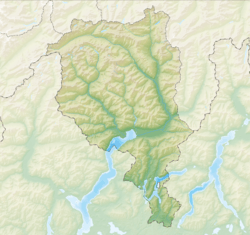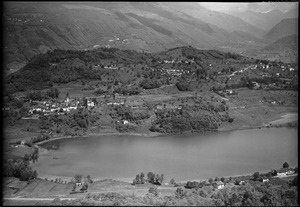Muzzano, Ticino facts for kids
Quick facts for kids
Muzzano
|
||
|---|---|---|
|
||
| Country | Switzerland | |
| Canton | Ticino | |
| District | Lugano | |
| Area | ||
| • Total | 1.56 km2 (0.60 sq mi) | |
| Elevation | 365 m (1,198 ft) | |
| Population
(Dec 2020 )
|
||
| • Total | 787 | |
| • Density | 504.5/km2 (1,307/sq mi) | |
| Postal code |
6933
|
|
| Surrounded by | Agno, Bioggio, Collina d'Oro, Lugano, Sorengo | |
Muzzano is a small town, also called a municipality, located in the Lugano area of Ticino, a canton (like a state) in Switzerland. It's a lovely place with a mix of history, nature, and modern life.
Contents
History of Muzzano
Muzzano was first mentioned in old records in the year 1189. Back then, it was known as Muciano. A nearby area called Agnuzzo was once the center of a large farm estate. In 819, a ruler named Emperor Louis the Pious gave this estate to the church leaders in Como.
Later, in the 11th century, the property became part of the Abbey of S. Abbondio in Como. An abbey is like a monastery where monks or nuns live. By 1579, the town of Muzzano and some private people started renting the land and rights from the Abbey.
Muzzano used to be part of the Pieve of Agno. A Pieve was a church district in the past. Muzzano became its own independent church area, called a parish, in 1735. The main church, S. Maria dell'Annunciazione, probably dates back to the 16th century. Another small church, the Chapel of S. Andrea in Agnuzzo, was first mentioned in 1208.
Many people from Muzzano used to work in construction, especially as plasterers. They would travel to other countries for work. The local economy also relied on silk farming, viticulture (grape growing for wine), and general farming.
In recent decades, an industrial area called Mulini Tues Biogno grew up along the Vedeggio river. The hills above the valley are now mostly covered with homes. Muzzano is also home to a small lake, Lago di Muzzano, which is a protected natural area. Since 1945, it has been looked after by Pro Natura, an organization that protects nature.
Muzzano also has a history of important schools. Alberto Lamoni started a school here in 1827. Later, Maria Boschetti-Alberti opened her Scuola Serena (Serene School) between 1917 and 1924. In 2000, about three-quarters of the people working in Muzzano traveled there from other places.
Geography of Muzzano
Muzzano covers an area of about 1.57 square kilometers (0.61 square miles). This was measured in 1997.
- About 33.8% of the land is used for farming.
- About 23.6% is covered by forests.
- About 40.8% has buildings or roads.
- About 15.3% is made up of rivers or lakes.
- A very small part, 0.6%, is unproductive land.
Looking closer at the built-up areas:
- Industrial buildings make up 8.3% of the total area.
- Houses and other buildings are 14.6%.
- Roads and other transport areas are 15.9%.
- Parks and sports fields make up 1.9%.
In the forested areas, 14.6% is dense forest, and 8.9% has orchards or small groups of trees. For farming land, 14.6% is used for crops, 4.5% for orchards or vineyards, and 14.6% for mountain pastures. The water in Muzzano includes 13.4% in lakes and 1.9% in rivers and streams.
The town is located in the Lugano district, just above Lago di Muzzano. It includes the main village of Muzzano and the smaller settlement of Agnuzzo.
Muzzano's Coat of Arms
The blazon (description) of Muzzano's municipal coat of arms is simple: it is divided into two horizontal halves. The top half is gold, and the bottom half is blue.
Population and People of Muzzano
Muzzano has a population of 861 people, as of 2023. In 2008, about 18.8% of the people living in Muzzano were foreign nationals. Over ten years, from 1997 to 2007, the population grew by 6.3%.
Most people in Muzzano speak Italian, which is 83.0% of the population. German is the second most common language, spoken by 10.3% of residents. French is spoken by 2.3% of the population.
In 2008, there were slightly more women (54.2%) than men (45.8%) living in Muzzano. The population included Swiss men, non-Swiss men, Swiss women, and non-Swiss women.
The age groups in Muzzano, as of 2009, show:
- Children (0-9 years old): 8.5%
- Teenagers (10-19 years old): 10.1%
- Young adults (20-29 years old): 12.7%
- Adults (30-59 years old): 42.2%
- Seniors (60 years and older): 26.5%
In 2000, there were 322 homes in Muzzano, with about 2.3 people living in each. Most of the buildings were single-family homes (69.7%). There were also some two-family buildings and multi-family buildings.
The chart below shows how Muzzano's population has changed over many years:

Important Sights in Muzzano
The entire village of Muzzano is recognized as part of the Inventory of Swiss Heritage Sites. This means it has special historical and cultural importance.
Muzzano's Economy
In 2007, Muzzano had an unemployment rate of 4.61%. This means that about 4.61% of people who wanted to work could not find a job.
In 2005, people in Muzzano worked in different economic sectors:
- Primary sector: 63 people worked in farming, fishing, or forestry. There were about 5 businesses in this area.
- Secondary sector: 560 people worked in manufacturing or construction. There were 16 businesses in this area.
- Tertiary sector: 141 people worked in services, like shops, hotels, or offices. There were 32 businesses in this area.
About 40.7% of the people working in Muzzano were women. In 2000, many people traveled into Muzzano for work (842 workers), while fewer people traveled out (271 workers). This means Muzzano is a place where many people come to work. About 21.5% of the workers coming into Muzzano were from outside Switzerland.
For getting to work, 7.7% of people used public transportation, and 65.6% used a private car. As of 2009, there was one hotel in Muzzano.
Religion in Muzzano
According to the 2000 census:
- 584 people (79.3%) were Roman Catholic.
- 68 people (9.2%) belonged to the Swiss Reformed Church.
- 72 people (9.78%) belonged to other churches not listed.
- 12 people (1.63%) did not answer the question about their religion.
Education in Muzzano
In Muzzano, about 76.1% of adults (aged 25–64) have completed either non-mandatory upper secondary education or higher education, like university.
As of 2009, there were 124 students in Muzzano. The education system in Ticino offers up to three years of non-mandatory kindergarten. In Muzzano, 22 children were in kindergarten.
The primary school program lasts for five years. In Muzzano, 38 students attended these primary schools. For lower secondary school, students can choose between two paths:
- A two-year middle school, followed by a two-year pre-apprenticeship program. There were 32 students in the two-year middle school.
- A four-year program that prepares students for higher education. There were 14 students in this advanced program.
Upper secondary school offers several choices to prepare students for a trade or for university.
- Vocational students can attend school while doing an internship or apprenticeship (3-4 years). There were 8 full-time vocational students and 8 part-time students.
- A professional program lasts three years and prepares students for jobs in fields like engineering, nursing, or business. There were 2 students in this program.
In 2000, 8 students came to Muzzano from other towns for school, while 83 Muzzano residents went to schools outside the municipality.
See also
 In Spanish: Muzzano (Tesino) para niños
In Spanish: Muzzano (Tesino) para niños





